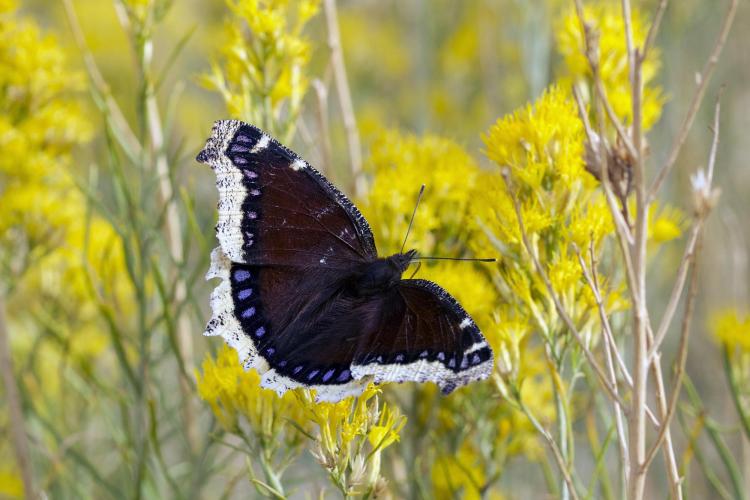Beavers feed mourning cloak butterflies
Mourning cloak butterflies, Nymphalis antiopa, have an immense geographic range that circles the globe in the northern hemisphere. They are native to North America, Europe and Asia, and in some areas they migrate with the seasons.
For example, mourning cloaks occupy the central valleys of California in spring, move to the high Sierra in summer, and return in fall. In Europe, they migrate between Germany and Greece. But mourning cloaks are also notable for their diets, feeding behavior, coloration, defenses and overwintering.
While most butterflies overwinter as eggs, larva or pupae, mourning cloak adults overwinter in crevices of bark or in leaf litter. They occasionally fly about on warm days in mid winter, and so they are frequently the first butterflies seen in spring and the last in fall. They seem to thrive in the colder environments at high latitudes and elevations.
A mourning cloak butterfly sips nectar from rabbitbrush flowers. Click on this link or photo to see larger image. Photo by Jeff Mitton.
When adults emerge in spring, males establish mating territories in protected sites or in prime feeding sites and court the females that visit their territories. Shortly after mating, females lay rings of eggs on the terminal branches of their host plants, so that first instar caterpillars can feed immediately. The host species are black willow, weeping willow, silky willow, American elm, plains cottonwood, quaking aspen, paper birch and hackberry.
Mourning cloak caterpillars are most commonly known as spiny elm caterpillars, a name that calls attention to their defensive spines. The caterpillars shapes and colors announce that they are defended and not to be trifled with. They grow to a length of two inches and are black with tiny white dots and a line of eight large, bright-orange dots on the back.
Rings of large, branched black spines protect the full length of the caterpillar. These can both pierce and deliver poison to a curious or threatening animal. Beneath the spines a coat of fine white hairs provides a second line of defense.
The spines are known to be urticating, or hooked in such a way that once embedded, they naturally work their way deeper. I suspect that the hairs are urticating as well. Contact with the spines and hairs creates a stinging sensation immediately and a prolonged, festering itch caused by urtication.
Amply defended caterpillars can enhance advertisement of their defense by feeding in dense aggregations that make their colors, horns and hairs more conspicuous. Furthermore, spiny elm caterpillars packed on top of a leaf can animate their advertisement by violently twitching in unison as a predator approaches, creating a bizarre and threatening display.
Feeding aggregations of spiny elm caterpillars can be seen from a hundred feet away and they are also made evident by defoliated patches of leaves. In contrast, caterpillars of species lacking defenses are cryptically colored and they feed individually, either at night or during the day from the underside of a leaf.
While caterpillars display overtly conspicuous behavior and warning coloration, adult mourning cloaks, lacking defenses, have colors and a pattern that camouflages them on tree bark. When they want to rest in safety, they land on bark and fold their wings so that only the ventral wing surfaces can be seen. The ventral surfaces have stripes of black and dark gray that look like tree bark.
I found the mourning cloak (in the accompanying photo) when I was trying to photograph the beavers living at the confluence of the Green and Yampa Rivers in Echo Park, Dinosaur National Monument.
I had been stalking the beavers for two days without success when this large, dark butterfly sipping nectar from bright yellow rabbitbrush blooms distracted me. At the time, the proximity of mourning cloaks and beavers did not occur to me, but background reading for this column has convinced me that their sympatry was more than random coincidence.
Mourning cloaks most prefer the sap of trees, but will also drink fluids from fermenting fruit and are only occasionally seen sipping nectar. Beavers at this site utilize Fremont’s cottonwoods, Populus fremontii, for food, which they cache on the riverbank. Beavers in British Columbia frequently cut aspen and cottonwoods, and numerous mourning cloaks feed on the sap flowing from them. Looking back on my encounter with the mourning cloak, the butterfly was not attracted by rabbitbrush, but by the beavers, which were inadvertently feeding it.


